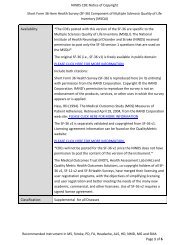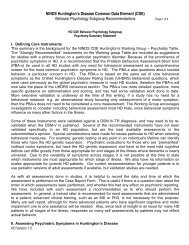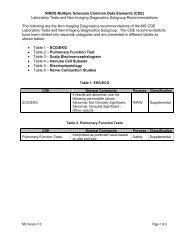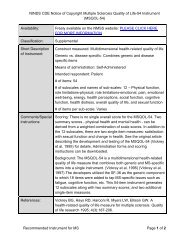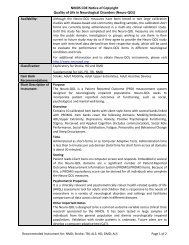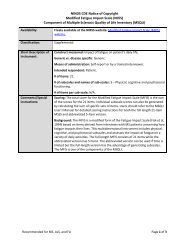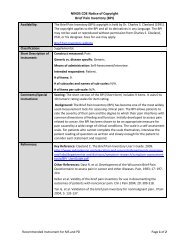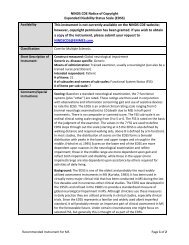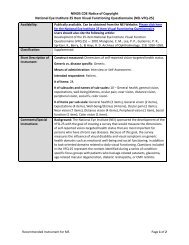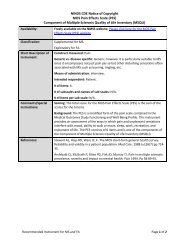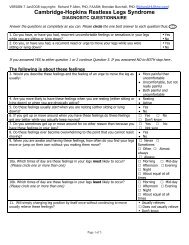NOC - NINDS Common Data Elements
NOC - NINDS Common Data Elements
NOC - NINDS Common Data Elements
Create successful ePaper yourself
Turn your PDF publications into a flip-book with our unique Google optimized e-Paper software.
<strong>NINDS</strong> CDE Notice of CopyrightUnified Huntington’s Disease Rating Scale (UHDRS)Availability:Classification:ShortDescription ofInstrument:ScoringReferences:Please visit this website for more information about the instrument: Click here forthe Huntington Study Group website.Core.The Unified Huntington’s Disease Rating Scale (UHDRS) is a research tool which hasbeen developed by the Huntington Study Group to provide a uniform assessment ofthe clinical features and course of HD.This Scale Consists of 6 Subtests:Motor Assessment.Cognitive Assessment.Behavioral Assessment.The Independence Scale.Functional Assessment.Total Functional Capacity.UHDRS 99:The UHDRS was updated in 1999 and represented improved effectiveness andapplicability.*The Symbol Digit Modalities Test (SDMT) and The Stroop Test are also included in theUHDRS but must be acquired separately*.Each question is scored individually. For the Cognitive component, the following testsare scored: Verbal Fluency, Symbol Digit Modality, Stroop Interference Test.The modified motor score consists of the sum score of items 4-10 and 13-15 of theUHDRS motor assessments.Marder, K., et al., Rate of functional decline in Huntington's disease. Huntington StudyGroup. Neurology, 2000. 54(2): p. 452-8.Paulsen, J. S., Wang, C., Duff, K., Barker, R., Nance, M., Beglinger, L. et al. (2010).Challenges assessing clinical endpoints in early Huntington disease. Mov Disord, 25(15),2595-2603.Beglinger, L. J., O'Rourke, J. J., Wang, C., Langbehn, D. R., Duff, K., Paulsen, J. S., et al.(2010). Earliest functional declines in Huntington disease. Psychiatry Res, 178(2), 414-418.Tabrizi SJ, Scahill RI, Durr A, et al. Biological and clinical changes in pre-manifest andearly stage Huntington's disease in the TRACK-HD study: the 12-month longitudinalanalysis. Lancet Neurol. Jan 2011;10 (1):31-42.Recommended Instrument for: HD Page 1 of 2
<strong>NINDS</strong> CDE Notice of CopyrightUnified Huntington’s Disease Rating Scale (UHDRS)ShortDescription ofInstrument:ShortDescription ofInstrument:ShortDescription ofInstrument:Total Functional Capacity (TFC)The Total Functional Capacity (TFC) is a brief interview involving the participant and aclose family member or friend familiar with the participant’s functioning. The measurehas 5 items and addresses basic activities of living: occupation, handling finances,domestic responsibilities, ADLs (eating, dressing, bathing), and Level of Care (home orfacility).The TFC focuses on assessment of CAPACITY rather than actual performance. Thisplaces emphasis on the clinician’s judgment and does not require rigorousdocumentation of performance. The TFC covers a wide range of basic aspects of dailyliving.The HDFCS is reported as the total TFC score. Higher scores on the function scalesindicate better functioning than lower scores.The Independence ScaleThe Independence is a useful clinical tool to follow disease progression in functionaldisability. It covers a wide range of functioning.The Independence Scale is rated from 100 (no special care needed) to 0 (tube-fed, totalbed care); descriptors are provided to gauge function levels at every 10 points.The Functional Assessment ChecklistThis Checklist is a 25 question Assessment that screens for Capacity to complete thetasks mentioned in the Assessment alone. It is considered an extension of the TotalFunctional Capacity in that it is more detailed in certain tasks.It is a 5-10 minute interview and the questions are to be asked in the presence of afamily or friend to get the clinician’s best judgment based on both responses.The checklist is summed by giving a score of 1 to all “yes” replies. Higher scores on thefunction scales indicate better functioning than lower scores.Recommended Instrument for: HD Page 2 of 2



